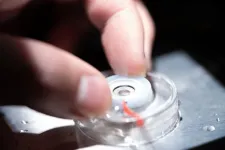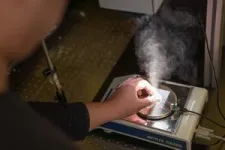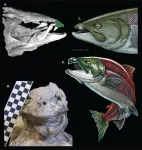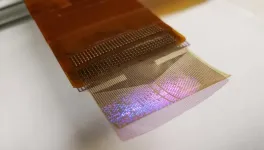It’s the most fundamental of processes — the evaporation of water from the surfaces of oceans and lakes, the burning off of fog in the morning sun, and the drying of briny ponds that leaves solid salt behind. Evaporation is all around us, and humans have been observing it and making use of it for as long as we have existed.
And yet, it turns out, we’ve been missing a major part of the picture all along.
In a series of painstakingly precise experiments, a team of researchers at MIT has demonstrated that heat isn’t alone in causing water to evaporate. Light, striking the water’s surface where air and water meet, can break water molecules away and float them into the air, causing evaporation in the absence of any source of heat.
The astonishing new discovery could have a wide range of significant implications. It could help explain mysterious measurements over the years of how sunlight affects clouds, and therefore affect calculations of the effects of climate change on cloud cover and precipitation. It could also lead to new ways of designing industrial processes such as solar-powered desalination or drying of materials.
The findings, and the many different lines of evidence that demonstrate the reality of the phenomenon and the details of how it works, are described in the journal PNAS, in a paper by Carl Richard Soderberg Professor of Power Engineering Gang Chen, postdocs Guangxin Lv and Yaodong Tu, and graduate student James Zhang.
The authors say their study suggests that the effect should happen widely in nature— everywhere from clouds to fogs to the surfaces of oceans, soils, and plants — and that it could also lead to new practical applications, including in energy and clean water production. “I think this has a lot of applications,” Chen says. “We’re exploring all these different directions. And of course, it also affects the basic science, like the effects of clouds on climate, because clouds are the most uncertain aspect of climate models.”
A newfound phenomenon
The new work builds on research reported last year, which described this new “photomolecular effect” but only under very specialized conditions: on the surface of specially prepared hydrogels soaked with water. In the new study, the researchers demonstrate that the hydrogel is not necessary for the process; it occurs at any water surface exposed to light, whether it’s a flat surface like a body of water or a curved surface like a droplet of cloud vapor.
Because the effect was so unexpected, the team worked to prove its existence with as many different lines of evidence as possible. In this study, they report 14 different kinds of tests and measurements they carried out to establish that water was indeed evaporating — that is, molecules of water were being knocked loose from the water’s surface and wafted into the air — due to the light alone, not by heat, which was long assumed to be the only mechanism involved.
One key indicator, which showed up consistently in four different kinds of experiments under different conditions, was that as the water began to evaporate from a test container under visible light, the air temperature measured above the water’s surface cooled down and then leveled off, showing that thermal energy was not the driving force behind the effect.
Other key indicators that showed up included the way the evaporation effect varied depending on the angle of the light, the exact color of the light, and its polarization. None of these varying characteristics should happen because at these wavelengths, water hardly absorbs light at all — and yet the researchers observed them.
The effect is strongest when light hits the water surface at an angle of 45 degrees. It is also strongest with a certain type of polarization, called transverse magnetic polarization. And it peaks in green light — which, oddly, is the color for which water is most transparent and thus interacts the least.
Chen and his co-researchers have proposed a physical mechanism that can explain the angle and polarization dependence of the effect, showing that the photons of light can impart a net force on water molecules at the water surface that is sufficient to knock them loose from the body of water. But they cannot yet account for the color dependence, which they say will require further study.
They have named this the photomolecular effect, by analogy with the photoelectric effect that was discovered by Heinrich Hertz in 1887 and finally explained by Albert Einstein in 1905. That effect was one of the first demonstrations that light also has particle characteristics, which had major implications in physics and led to a wide variety of applications, including LEDs. Just as the photoelectric effect liberates electrons from atoms in a material in response to being hit by a photon of light, the photomolecular effect shows that photons can liberate entire molecules from a liquid surface, the researchers say.
“The finding of evaporation caused by light instead of heat provides new disruptive knowledge of light-water interaction,” says Xiulin Ruan, professor of mechanical engineering at Purdue University, who was not involved in the study. “It could help us gain new understanding of how sunlight interacts with cloud, fog, oceans, and other natural water bodies to affect weather and climate. It has significant potential practical applications such as high-performance water desalination driven by solar energy. This research is among the rare group of truly revolutionary discoveries which are not widely accepted by the community right away but take time, sometimes a long time, to be confirmed.”
Solving a cloud conundrum
The finding may solve an 80-year-old mystery in climate science. Measurements of how clouds absorb sunlight have often shown that they are absorbing more sunlight than conventional physics dictates possible. The additional evaporation caused by this effect could account for the longstanding discrepancy, which has been a subject of dispute since such measurements are difficult to make.
“Those experiments are based on satellite data and flight data,“ Chen explains. “They fly an airplane on top of and below the clouds, and there are also data based on the ocean temperature and radiation balance. And they all conclude that there is more absorption by clouds than theory could calculate. However, due to the complexity of clouds and the difficulties of making such measurements, researchers have been debating whether such discrepancies are real or not. And what we discovered suggests that hey, there’s another mechanism for cloud absorption, which was not accounted for, and this mechanism might explain the discrepancies.”
Chen says he recently spoke about the phenomenon at an American Physical Society conference, and one physicist there who studies clouds and climate said they had never thought about this possibility, which could affect calculations of the complex effects of clouds on climate. The team conducted experiments using LEDs shining on an artificial cloud chamber, and they observed heating of the fog, which was not supposed to happen since water does not absorb in the visible spectrum. “Such heating can be explained based on the photomolecular effect more easily,” he says.
Lv says that of the many lines of evidence, “the flat region in the air-side temperature distribution above hot water will be the easiest for people to reproduce.” That temperature profile “is a signature” that demonstrates the effect clearly, he says.
Zhang adds: “It is quite hard to explain how this kind of flat temperature profile comes about without invoking some other mechanism” beyond the accepted theories of thermal evaporation. “It ties together what a whole lot of people are reporting in their solar desalination devices,” which again show evaporation rates that cannot be explained by the thermal input.
The effect can be substantial. Under the optimum conditions of color, angle, and polarization, Lv says, “the evaporation rate is four times the thermal limit.”
Already, since publication of the first paper, the team has been approached by companies that hope to harness the effect, Chen says, including for evaporating syrup and drying paper in a paper mill. The likeliest first applications will come in the areas of solar desalinization systems or other industrial drying processes, he says. “Drying consumes 20 percent of all industrial energy usage,” he points out.
Because the effect is so new and unexpected, Chen says, “This phenomenon should be very general, and our experiment is really just the beginning.” The experiments needed to demonstrate and quantify the effect are very time-consuming. “There are many variables, from understanding water itself, to extending to other materials, other liquids and even solids,” he says.
The work was partly supported by an MIT Bose Award.
###
Written by David L. Chandler, MIT News
Paper: “Photomolecular effect: visible light interaction with air-water interface”
https://www.pnas.org/doi/10.1073/pnas.2320844121
END









